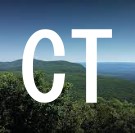The short answer: Occasionally one can find subtle signs of their presence in areas they happen to be feeding in. Those signs may be "observable," but they are only noticeable if you know what you are looking for. When skeptical scientists talk about an "observable effect on the environment," they mean destructive effects that are so pronounced and dramatic that anyone would immediately notice the aftermath of foraging bigfoots.
The "Observable Effect" Argument
When the fatal flaws of all the other anti-bigfoot arguments are exposed, the "observable effect" argument is usually the final card played by debating skeptics. But even that argument is easily deconstructed.
The following is a passage from a scientific text which addresses the Giganto-Bigfoot Theory. It mentions the "observable effect" argument as it typically presented -- with no substantiation:Some suggest that [gigantos] did not in fact become extinct, and continue to exist as the Sasquatch and the Yeti. [Gigantos] could have crossed the Bering Land Bridge, the same way humans are thought to have entered the New World (Geoffrey Bourne, 1975, cited in Ciochon et al., 1990). So far, though there have been many alleged sightings, no physical evidence has been recovered. One is led to suspect that the question of Sasquatch (and related entities) is more for comparative mythology, cultural anthropology, or psychology, since an actual creature the size of [giganto] existing in numbers sufficient to qualify as a breeding population would not only leave physical remains, but would have an observable effect on their environment.
(From the Teeth of the Dragon - Gigantopithecus blacki by Eric Pettifor) The observable effect argument is based on the behavior of African mountain gorillas. It assumes that gigantos in North America would live the same way. Specifically that:- Surviving gigantos would live in sizeable troupes like African mountain gorillas.
- Troupes of gigantos would stick to the same mountain sides for generations, like African mountain gorillas.
- Gigantos would be basically strict herbivores like African mountain gorillas.
- African plants and trees are like North American plants and trees.
- Gigantos would forage in North American coniferous forests the same way mountain gorillas forage in tropical African forests.
If we step back from these presumptions, without concluding that they are all definitely false, but rather accepting that they are merely unsupported premises, then we can focus on the important mathematical factor:
If the population of surviving gigantos (bigfoots) in North America is somewhere in the ballpark of 2000-6000, or less, with a minimal breeding population of roughly 300, then there are exponentially more deer and elk sharing the same environment. Deer and elk, therefore, have an exponentially greater effect on the natural environment than bigfoots. But that exponentially greater effect is ... not noticeable at all unless someone shows you what to look for.
In North American forests, forage is mainly the soft tips of mature plants and trees, wild fruits and berries - things that are not very noticeable when they are gone. Targeting these types of food sources does not leave an "observable effect on the environment," in the same way that gorilla groups leave an observable effect in their tropical environment. Bigfoots apparently target the same choice parts of plants and trees as deer. Calorie for calorie it's the most efficient use of their foraging energy in North American forests -- forests that don't have bamboo groves, or the fleshy tropical broad-leafed trees and plants that mountain gorillas tend to tear apart.
Even though bigfoots don't have tropical plants to feed on in North America, there is lots of coniferous forest forage here if you need to find it. Bigfoots can reach higher than deer and elk, so there is always more than enough for them to choose from in the growing seasons, no matter have much deer and elk competition they have. Reports and other evidence suggest they are predatory also, and seem to become more predatory in the winter months when the forage options are reduced.
Between their ability to reach where other large forest foragers cannot reach, and their predation on other forest foragers when necessary, they have an enormous amount of food to select from in North America -- more than enough for a breeding population, without having to tear apart trees or cause any other "observable effect on the environment."
Bigfoots do break branches and saplings occasionally, seemingly to mark trails, but that is nothing like the forest demolition performed by troupes of mountain gorillas in Africa. The occasional branch breakage above and alongside game trails in North America is visible, but it is not very dramatic. Most people would never pay much attention to these trail markers if they passed by them. If trail markers are observed by an average wildlife biologist who is not knowledgeable on this subject, he/she would never suspect a surviving wood ape as the culprit, even if there was no other apparent explanation for the characteristic twisting that requires enormous strength and can only be accomplish by something with hands. |

















